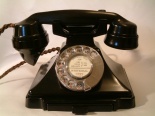| Buying and Selling British Bakelite Telephones | |||
|
MENU |
This website has been set up to give guidance on buying and selling old British Telephones. Genuine British Bakelite Telephones have become much more collectable in the last few years and hence more expensive, as such it is more important that ever to make sure you are getting the real thing. Advice on Buying Bakelite TelephonesThe Telephone ManufacturersMost Bakelite Telephone collectors agree that there is no substitute for Classic British manufactured Bakelite Telephones. When it comes to Antique Telephones British is Best. Look for UK Manufactures of 300 series bakelite telephones
Avoid non UK Bakelite Telephone Manufactures
At one end of the scale are the "Genuine Bakelite" telephones made in Indian these are of particularly poor quality when compared to the original British versions. The main reason for this is that ITI (Indian Telephone Industries) made these Bakelite telephones to a cost out of cheaper materials and to a cheaper design for the local mass market in India. However at the other end of the scale AWA (made in Australia) telephones are of equal quality to there British counterparts, its just that UK collectors are not as keen to obtain them. In the middle the Israel (Telrad) and Portuguese (AEP) telephones are reasonable quality, however the AEP telephones often have slightly different cases and markings making them far less collectable on the British market. Genuine Chrome DialsThe most complex and expensive part of an antique telephone is the chrome dial. Original chrome dials are far superior to modern replica chrome dials, or plastic dials. A true Vintage Telephone should have a genuine original chrome dial. The problem is a that a lot of these original dials have been swapped out, rather than repaired over the years for cheap imitations. The condition of the BakeliteBakelite (the first plastic) is a lovely material which is why it was used to make jewellery etc, however its one weakness is that if it is damaged (such as cracks) it is virtually impossible to repair. Examine the telephone extremely carefully for thin hairline cracks. Small chips (nibbles) a few mm in size are acceptable but cracks are not. Again check for excessive fading (by prolonged exposure to direct sunlight over many years). Lastly check the surface condition of the bakelite, excessive "cleaning" with abrasive materials can damage the surface layer. The Handset CordMost British Bakelite Telephones (not GEC) started their life with a plaited braided handset cord between the telephone handset and the case. In the 1950's a lot of these were swapped out by the GPO for more reliable plastic curly handset cords. The choice between braided and a plastic curly handset is down to personal preference, however check that if it is a plastic curly type that it is the original version designed specifically for Bakelite telephones rather than the modern version designed for the later plastic 706 and 746 telephones, as these are very different. The original Braided cords do tend to wear out and I believe it is acceptable to use reproduction replacements, but only if they are made by hand in Britain to the same standard as the originals. Always check, the difference between a mass produce factory fake braided handset cord and a good quality hand made version is huge. The Internals of the telephoneThis is the most difficulty to check, and requires taking the telephone apart . A genuine collectable telephone should have been "sympathetically" converted to work on the modern telephone system. This means that no parts such as bells, capacitor, induction coil etc should have been removed or replaced. The one exception to this is the microphone (see modern microphone section). |
||
| 300 series | 300 Series telephones made in the 1940's and 1950s. Although some of these dial phones were also made in the early 1960's. Unlike the earlier 200 series vintage telephones these bakelite telephones have Internal bells. Classic 300 series bakelite model numbers include the 332, 312, 314 and 328. | ||
| 200 series |  |
200 Series telephones were made in the 1930's 1940s and 1950's. These telephones were designed to be used with an external bell sets (usually placed in the entrance hall) . They are very Art Deco but they do not contain any internal bells. A separate bell set is needed to make these telephones work. These telephones had model numbers 165 and later 232. | |
Other useful Telephone resources that contain information about classic British telephones can be seen below
Antique Telephones
- Antique Telephone Blog
- Old RetroTelephone Blog
- Antique Telephones for Sale
- Spare Parts & Repairs Antique Telephones
- Vintage Bakelite Phones
- Bakelite Telephone Resources
- Antique Telephone Resources
Retro Telephones
Vintage Telephones
